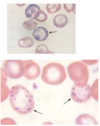Porphyria Flashcards
Porphyrias result from a mutation in WHAT
one of the enzymes in the heme biosynthetic pathway
Clinical manifestations of porphyrias results from WHAT
Accumulation of toxic metabolites (porphyrins) that cannot be cleared, due to deficient enzyme action.
The porphyrins have no useful function and act as highly reactive oxidants and damage tissues
Inheritance pattern of porphyrias:
These enzyme deficiencies are inherited as autosomal dominant, autosomal recessive, or X-linked traits, with the exception of porphyria cutanea tarda (PCT), which usually is sporadic.
Heme is part of hemoglobin, ____, _____, ____, and ____
Heme is part of hemoglobin, myoglobin, catalases, peroxidases, and cytochromes
Heme is made in what cells?
Heme is made in every human cell (85% in erythroid cells & much of the rest in the liver, where it is used to make the P450 cytochromes)
What is the rate-limiting step of heme synthesis?
First (and rate-limiting) enzyme in heme synthesis pathway is Aminolevulinic acid (ALA) synthetase (ALAS)
Increased demand for ____ induces ALAS
heme
The heme molecule downregulates ___ by feedback inhibition
ALAS
ALAS:
ALAS is a mitochondrial enzyme that catalyzes the conversion of glycine and succinyl CoA to form delta-aminolevulinic acid. This requires pyridoxal-5’-phosphate as a cofactor.

How is ALAS1 induced? Why are these important clinically?
- Depletion of the hepatic pool of heme
- Drugs, hormones which induce CYPs (and ALAS1)
- Caloric and carbohydrate restriction
- Metabolic stress, which may induce hepatic heme oxygenase and accelerate heme destruction
These are the same things that can induce a flare of the porphyria AIP
If there’s a downstream block of heme synthesis, then inducing ____ feeds raw materials into the ____ cycle, leading to backup accumulation of the toxic porphyrins—giving symptoms of the respective porphyria
If there’s a downstream block, then inducing ALAS feeds raw materials into the porphyria cycle, leading to backup accumulation of the toxic porphyrins—giving symptoms of the respective porphyria
Acute Intermittent Porphyria is caused by a deficiency of _____
hepatic PBG deaminase (aka hydroxymethylbilane synthase)
What is the inheritance pattern of AIP?
Autosomal dominant with incomplete penetrance
Affected individuals with AIP have a 50% reduction in _____ activity
erythrocyte PBG deaminase activity
When does AIP appear clinically?
Generally around/after puberty
What populations are affected by AIP?
Symptoms more common in females than males
How is AIP diagnosed?
Test urine ALA and PBG during crisis - increased levels suggest AIP.
In addition to low levels of PGBD activity, disease expression requires _____
induction of ALAS1
Describe the clinical symptoms of an acute AIP attack:
GI symptoms - esp. abdominal pain (distinct from e.g. appendicitis because no inflammatory signs)
Peripheral neuropathy - sensory and motor neuropathy may precede abdominal pain. Prolonged attacks can result in bulbar paralysis, respiratory impairment, and death.
Increased catecholamines
Elevated heart rate and BP
Seizures
SIADH - hyponatremia
Dark or reddish-brown urine
What are factors that can exacerbate an acute attack of AIP?
•Drugs that increase demand for hepatic heme (especially cytochrome P450 enzymes)
•Crash diets (decreased carbohydrate intake)
•Endogenous hormones (progesterone)
•Cigarette smoking (induces cytochrome P450)
•Metabolic stresses (infections, surgery, psychological stress)
How is AIP diagnosed?
•Send urine for PBG and ALA during an acute exacerbation
•If these are not elevated, then stop.
•If these are markedly elevated, then send PBG deaminase enzyme activity (decreased in 90% of patients, even in asymptomatic periods)
•Genetic testing is available.
A slight elevation of urine or stool prophyrins with a normal urine ALA and PBG IS/IS NOT porphyria:
IS NOT!
- These are relatively non-specific, especially if only minimally elevated.
- Unlike AIP (or other acute porphyrias), other causes of abdominal pain do not cause elevations of urinary PBG. However, other causes of abdominal pain may be associated with elevations in urinary porphyrins (eg, hepatobiliary disease) or ALA (lead poisoning).
How should an acute AIP attack be treated?
•Hospitalization to control/treat acute symptoms:
•Withdraw all unsafe medications
•Monitor respiratory function, muscle strength, neurological status
•Intravenous 10% glucose at least 300 g per day
•Intravenous hematin ASAP (can give IV glucose while waiting for IV hematin)—hematin is heme, which can feedback inhibit ALA-synthase.
- Cimetidine for treatment of crisis and prevention of attacks
- In rare instances where pts have severe, unremitting symptomatic disease, liver transplantation has been done
- There is a clinical trial using siRNA to shut off synthesis of ALAS1 for patients with frequent relapses
Hematin mechanism of action:
Reduces production of ALA /porphyrins by negative feedback inhibition on ALA synthetase
Derived from outdated PRBCs from community blood banks




